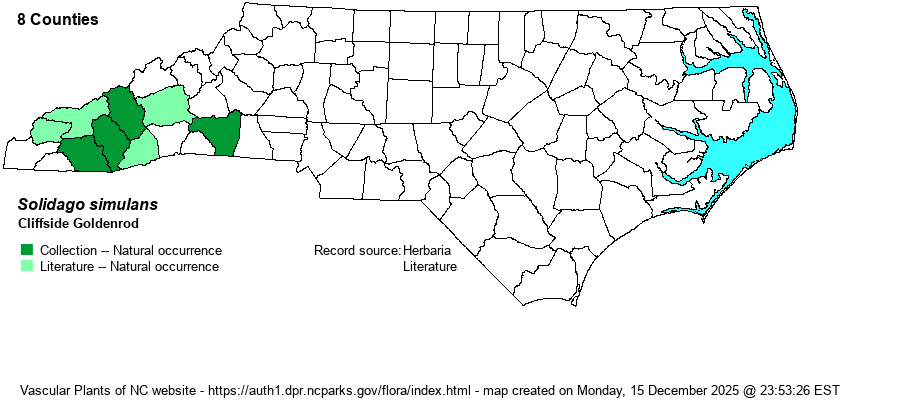| Section 6 » Order Asterales » Family Asteraceae |
Show/Hide Synonym
| taxonName | relationship | relatedTaxonName | relatedTaxonRefText | relComments |
|---|
|
| Solidago simulans | < | Solidago uliginosa | Flora of North America (1993b, 1997, 2000, 2002a, 2002b, 2003a, 2004b, 2005, 2006a, 2006b, 2006c, 2007a, 2009, 2010) | | | Solidago simulans | < | Solidago uliginosa | Radford, Ahles, and Bell (1968) | | | Solidago simulans | < | Solidago gracillima | Vascular Flora of the Southeastern States (Cronquist 1980, Isely 1990) | | | Source: Weakley's Flora |
|
| Author | Fernald | |
| Distribution | Southern Mountains only. Records from Yancey and Ashe counties in SERNEC are S. uliginosa. This species has typically been (erroneously) lumped into S. uliginosa, which is a bog species as opposed to a rock outcrop species.
Endemic to southwestern NC, northwestern SC, and northeastern GA. | |
| Abundance | Rare to uncommon in the southern half of the Mountains, but within its limited habitat -- exposed montane rock domes -- it is fairly common. The NCNHP database has over 40 records, of which at least half are in good to excellent condition. The State Rank of S2 is rather conservative, and S2S3 is probably more realistic. It is a Significantly Rare species. Note that it has a small range and a Global Rank of G2; thus, NC has most of the sites in the entire range. | |
| Habitat | Moist mossy patches and soil mats on granitic domes, as well as in thin soil within montane cedar-hardwood stands. | |
| Phenology | Flowering and fruiting August-September. | |
| Identification | Plants grow 1.5-2.5 feet tall from a rosette or patch of elliptical, stalked basal leaves up to a foot long. Stem leaves are much smaller and eventually become sessile (stalkless) and narrowly lance-shaped. The inflorescence is rather cylindrical and up to 7 inches long, rather densely flowered. Although thought to be related to S. gracillima/austrina, it has a much more robust gestalt, shorter stature, and different habitat and range. In the field it looks most like S. uliginosa, but differs in its glabrous inflorescence, larger involucral bracts, and pubescent seeds. That species is almost always found in damp to wet flat ground, of bogs, wet meadows, and seepage swamps. | |
| Taxonomic Comments | Ignored or overlooked by botanists and authors for many decades, including FNA, this plant has only recently become resurrected.
| |
| Other Common Name(s) | Fall Goldenrod, Granite Dome Goldenrod. Most references use the unhelpful Fall Goldenrod; nearly all goldenrods bloom in the fall. | |
| State Rank | S2 | |
| Global Rank | G2 | |
| State Status | SR-L | |
| US Status | | |
| USACE-agcp | | |
| USACE-emp | | |

